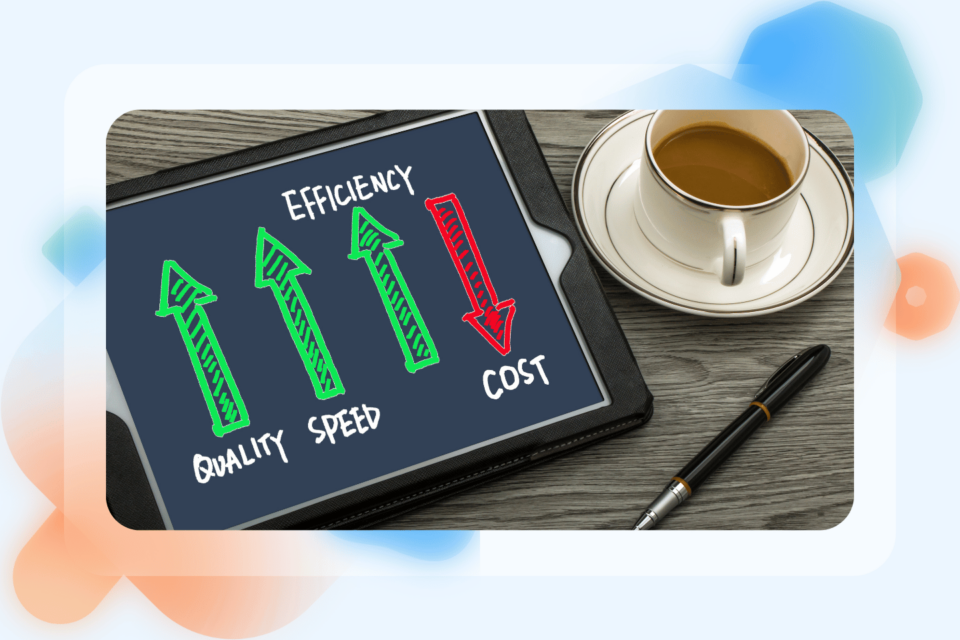Picture this: One day,a product is delivered damaged to a customer. Upset, he contacted support. In no time, a rep takes ownership of the case, reaches out, investigates, and resolves the situation promptly. In short, the business was able to provide effective and efficient customer service. What’s the outcome? The once-frustrated customer is not only appeased—but maybe even places another order.
Is this scenario just wishful thinking of business owners? No—it’s actually a powerful illustration of why 93% of consumers tend to make repeat purchases after a positive customer service experience.
You, too, can make this your new standard for delivering service by understanding the ten ways to improve your customer service efficiency.
But first, a little clarification…
Customer service effectiveness vs customer service efficiency

Let’s keep this simple:
- Customer service effectiveness focuses on the quality of the service provided
- Customer service efficiency is all about the speed and overall cost-effectiveness of the operations used to achieve that service.
3 key indicators of customer service effectiveness
- First Contact Resolution (FCR): Are customer issues being resolved on the first try? The higher the FCR, the more effective the service. It means a large percentage of inquiries are being solved right away.
- Customer Satisfaction (CSAT): How satisfied are customers with the interaction? A higher CSAT score signals effectiveness.
- Net Promoter Score (NPS): Are customers likely to recommend your brand after engaging with your service team?
3 key indicators of customer service efficiency
- Average Response Time (ART): How quickly does your team respond to inquiries?
- Handling Time: How long does it take to resolve each issue? The faster, the more efficient.
- Cost per Resolution: Lowering the cost of resolving each issue while maintaining quality is a hallmark of efficiency.
The trade-off
Overemphasis on efficiency without regard for effectiveness or quality can lead to poor customer experiences. Research revealed that 8 out of 10 customers switched because the customer service was unsatisfactory. Likewise, too much focus on effectiveness alone causes unsustainable costs and resource allocation. For example, slow lead response times can increase churn by 15%.
So in customer service, you don’t choose one over the other. You must combine both for long-term customer satisfaction. The goal is to create a customer service department that is both efficient in its processes and effective in its outcomes.
Why customer service efficiency matters

Being efficient in customer service is a fundamental driver of business growth. Why? Because it means your team isn’t just going through customer interactions (speeding through calls or closing tickets faster), but handling more customer issues with fewer resources (lower operational costs, too!)—and about 50% of sales go to fast responders.
Here’s the nitty-gritty on why efficient customer service rocks:
- While competitors might lose customers due to slow response times and clunky processes, your business could thrive and win over shoppers by offering seamless, efficient support.
- Efficient customer service equates to minimal friction when customers reach out for support. And if they have an easy time getting in touch with your support team, there’s a higher chance of them becoming loyal to your brand.
- Efficient systems let your team manage increased customer volume without increasing manpower and spending more on resources. To put it simply, efficiency helps you grow without compromising service quality.
- Speed becomes synonymous with reliability—and that’s a reputation you want. And that satisfaction shows up in reviews, referrals, and repeat business.
- Efficient customer service skills = a team that’s not bogged down by mundane processes. The result? A more engaged workforce and a more delighted customer base.
The cost of inefficient customer service
- Poor customer service creates a transactional relationship, not an intimate one. When your support is slow or ineffective, customers only stick around until they find a better option. No retention.
- You’ll miss opportunities for upselling and building deeper relationships just because your agents are bogged down with inefficient processes. They’ll be too busy solving routine issues, rather than nurturing existing customers so they become loyal.
- The repercussions of poor service are far-reaching, impacting everything from churn rates to revenue growth. Approximately $3.7 trillion is at risk each year.
10 tips to improve customer service efficiency

As promised, here are 10 actionable tips to help improve customer service efficiency so your operations are leaner, faster, and more satisfying for your customers.
1. Set clear expectations for your team and customers
Efficiency starts with clarity. When everyone (your team and your customers) knows what to expect, it sets the foundation for smooth interactions. Think of it as setting a schedule so both parties are aware of the timeline and are on the same page.
Best practices:
- Set realistic deadlines for deliverables so your team stays accountable.
- Establish standards for when and how to escalate issues.
- Define the quantifiable metrics to measure success.
2. Regularly review policies and processes
Sure, you strive for growth. But that also exposes inefficiencies that didn’t exist when your team was smaller. So, why should your policies and processes be static? Regularly reviewing them is the key to being proactive and making sure your team isn’t held back by outdated processes.
So sit down with your team and take a hard look at your current policies. Are they as easy to follow as you think they are? Do they still support efficient customer resolutions? Or have they become cumbersome over time?
Best practices:
- Schedule policy reviews to keep things fresh and ensure you’re always adapting.
- Tap into the experience of those working on the front lines. They’ll offer insights like the practical roadblocks that KPIs might gloss over.
- Make sure the numbers match what your agents are experiencing on the ground.
3. Implement SLAs (Service Level Agreements)
SLAs act as a blueprint for how quickly and accurately your team should respond to customer inquiries. It typically includes:
- The maximum time a customer should wait for a response to their inquiry.
- The length of time it should take to resolve a customer’s issue.
- Percentage of issues resolved on the first contact.
- Service availability.
- Performance indicators.
Best practices:
- Make sure the response and resolution times are achievable for your team and reasonable for your customers.
- Use SLAs to track the team’s performance against these goals. You may need to adjust your service load or customer needs as they change.
- Tailor service level agreements to different service tiers (for example: VIP vs standard customers).
- Make SLAs visible to your team and customers.
- Continuously monitor adherence to SLAs and tweak as necessary.
4. Optimize shipping and fulfillment process
Shipping and fulfillment inefficiencies can spiral into full-blown customer service disasters. A delayed shipment might seem like a simple hiccup, but for a customer, it’s a major inconvenience. And the consequence? Increased customer service inquiries, negative reviews, and the risk of losing future business.
Best practices:
- Work with dependable shipping providers that offer transparent tracking and reliable timelines.
- Offer multiple shipping options for customers to choose from.
- Communicate proactively if there’s a shipping delay.
- Integrate real-time tracking systems for customers, so they don’t have to call.
- Regularly evaluate the performance of your fulfillment partners.
5. Simplify returns and refunds
If there’s one surefire way to lose a customer’s trust, it’s making the returns or refund process a hassle. A complicated returns or refund process is one of the quickest ways to increase support volume. Simplify it, and your support team will have less work and your customers will be more loyal.
Best practices:
- Give customers complete information about return or refund procedures, and include any timelines and conditions.
- Make the return process as self-service as possible. Provide clear FAQs or video tutorials for your customers/
- Use customer service tools that let customers process returns or refunds online without needing direct support from your team.
6. Use automation tools
Automation is a strategy to transform how your customer service team operates. With the right tools and software in place, you can eliminate manual bottlenecks, reduce response times, and let your team focus on the tasks that actually require a human touch.
Best practices:
- Use AI-powered chatbots to handle repetitive tasks like password resets or FAQs but make it easy for customers to reach a human agent for complex issues.
- Continuously update your chatbot’s knowledge base for accuracy because an outdated chatbot does more harm than good.
- Use software automations that bring everything—email, chat, social media, and more—under one roof.
- Set up criteria-based routing that automatically assigns tickets based on issue type, customer tier, or agent expertise.
- Even the best systems need fine-tuning so regularly review routing rules to ensure accuracy.
7. Create an internal knowledge base
An internal knowledge base plays just as important a role as a customer-facing knowledge base. By providing agents with easy access to product updates, service policies, and troubleshooting guides, you empower them to find answers quickly.
Best practices:
- Include a search function so that information can be retrieved more quickly.
- Encourage agents to contribute by adding tips or updating solutions.
- Ensure someone is regularly reviewing and updating content so that agents always have the latest information at their fingertips.
8. Empower customers with self-service options
While this may not directly impact your customer service team’s efficiency, it significantly enhances your overall service quality. Customers appreciate self-service options because they provide control and save time. For your team, these options reduce the volume of repetitive inquiries, allowing them to concentrate on more complex issues that require personalized attention.
Best practices:
- Track the most frequently asked questions and create resources around them. Build a comprehensive library of FAQs, how-to articles, and video tutorials for customers to access at any time.
- Continuously update your knowledge base with the latest information.
- Set up a system that suggests self-help resources to customers when they initiate a chat or email.
- Include a search function for easy navigation.
9. Set up canned responses for common issues
While you never want your customer service to come across as impersonal or robotic, having well-thought-out, pre-written responses for frequent issues can significantly reduce resolution time—without compromising the quality of the interaction. There are always those recurring questions: “How do I reset my password?” or “Where’s my shipment?”
Best practices:
- If there are standard questions that come up regularly have well-crafted responses ready to go.
- Canned responses should only serve as a base that agents can tweak and personalize depending on the customer’s unique needs.
- Regularly review and update canned responses for relevancy.
- If a particular response consistently leaves customers with follow-up questions, that’s a sign it may need more clarity or detail.
10. Use data to drive decision-making
Efficiency skyrockets when your decisions are grounded in hard data. It’s about analyzing performance metrics to uncover inefficiencies and making strategic, data-backed adjustments that optimize your customer service workflow.
Best practices:
- Keep an eye on metrics like Average Resolution Time (ART), Customer Satisfaction (CSAT), and First Contact Resolution (FCR) to see efficiency gaps.
- If data shows certain workflows are taking too long, look into automation or process refinement.
- Run weekly reports to stay on top of key metrics.
- Involve agents in data reviews to identify areas for improvement.
Deliver exceptional, faster, and better service
And there you have it—10 actionable strategies to supercharge your customer service efficiency. Implementing these steps can be the game-changer to forming your very own support dream team. Because when your CS agents operate efficiently, it leads to quicker response times, more accurate resolutions, and happier customers.
But here’s the catch—peak seasons like Black Friday and Cyber Monday can make everything extra tough especially when customer inquiries spike. Pro tip? Outsource to LTVplus. Our team specializes in optimizing customer interactions to ensure efficiency at every step. That means you can focus on growth while you ensure your customers get the quick, quality support they deserve. Book a FREE call today and let’s talk!





